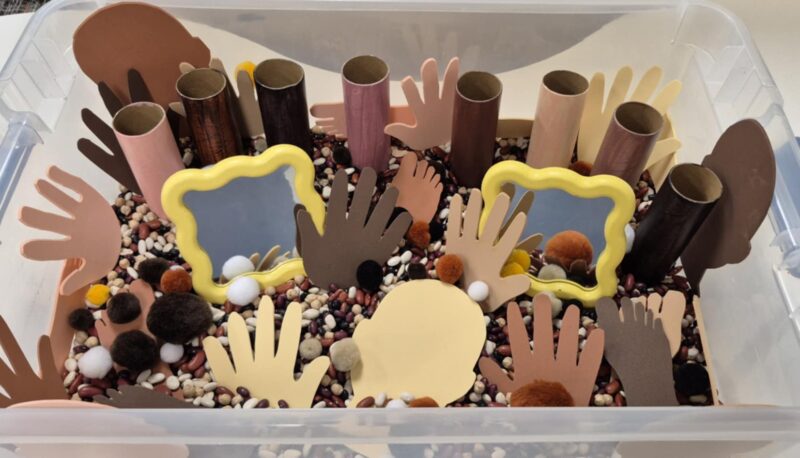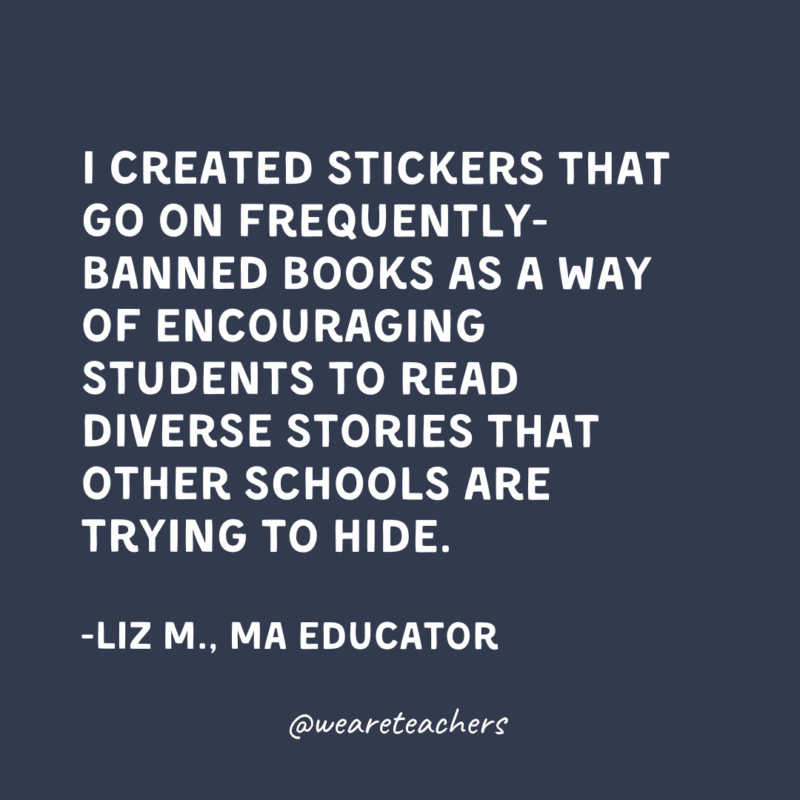Creating safe, inclusive classrooms feels more challenging in some places across the United States—but it’s far from impossible. Here’s how real teachers are ensuring that every student and family feels safe, seen, and welcome in 2025.
Teaching in 2025: The Challenges of a Divided Country
Ten Commandments posters in classrooms. Bans on signs that say “All Are Welcome.” More and more books banned from school and classroom library shelves. Diverse and inclusive topics off-limits. For many teachers, these are the realities of teaching in 2025 (and it’s driving some right out of the classroom). While many of these restrictions may eventually be overturned by local and federal courts, the community sentiment often lingers.
In a recent survey, teachers told us they’ve been requested or required to avoid discussion of LGBTQ+ subjects, lessons on slavery and women’s rights, and ICE raids at schools. These stories aren’t new, of course. For decades, administrators and legislators have placed restrictions on what teachers can say and do in their classrooms when it comes to diversity, equity, and inclusion topics. But the situation has gotten tougher in many areas over the last few years.
“My administrators have advised me to avoid discussions about politics, deportations, and LGBTQ+ issues,” one Colorado high school teacher told us. “I also have been instructed to steer students away from sharing their opinions on these issues. Similarly, I have been advised not to put up any posters in my classroom that might offend (conservative) parents who visit the school.”
Another high school teacher noted that their school has banned many books for language or content, often those featuring diverse characters. “So in the end, we teach almost no books that have Black characters because of fear of offending someone or fear of exposing actual social problems the Black community has faced.”
How To Create Inclusive, Welcoming Classrooms Despite Restrictions
Here’s the good news: Teachers across the country are still dedicated to making their students feel safe and welcome in their classrooms. They’re finding creative, thoughtful ways to comply with new restrictions while still ensuring everyone feels seen and represented. Here are their suggestions and ideas for creating your own inclusive classroom, no matter where you teach.
1. Change your wording, but keep the message.
This past spring, one Idaho teacher went viral for sharing her banned “Everyone Is Welcome Here” sign. In response, the State of Idaho doubled down, passing a law that specifically bans school signs that “represent a political, religious, or ideological viewpoint”—a broad category, to say the least.
While Idaho is the first to put this type of ban into law, plenty of teachers face opposition to their diverse and inclusive classroom decor. So, how are teachers dealing with bans like these? They’re choosing their words with care.
“I have been more creative with signs for displays,” says a Kansas teacher. “It might say ‘Stand Up for What Is Right’ rather than using words like ‘social justice.’ Or I might reference welcoming ‘newcomers’ rather than using the term ‘immigrant.’”
Krys E. teaches in Alaska and uses a lot of social-emotional learning materials that say things like “Be Strong” or “Be a Leader.” Wording like this avoids recommending specific actions but encourages students to make the choices that feel right for them.
2. Use images of your students and their families to decorate the classroom.
What better way to make everyone feel seen than by literally hanging them on your classroom walls? “I am having my students (a diverse group) draw and create decorations that represent them,” says a Texas preschool teacher. She plans to hang family photos with all types of diversity shown, plus self-portraits reflecting a variety of skin tones and individual differences.
Several teachers recommended hanging family photo walls in your classroom, so every student has a chance to be represented. Encourage families to share pics of themselves celebrating the holidays they love, eating or cooking their favorite foods, or participating in community events. Tip: If families aren’t comfortable sharing pictures, have kids draw their families instead.
3. Hang a culture wall.
Looking for a good back-to-school activity? Here’s what one Colorado high school teacher does to set the tone for a welcoming environment: “I have students create a culture wall to honor diversity in the classroom. They can make a poster about their own culture, or they can choose another culture that interests them. The posters usually include the country’s flag, national food, national animal, currency (money), famous figures, landmarks, etc.”
4. Reach out to and welcome all families.
The best way to make people feel safe and welcome? Tell them that they are, and demonstrate it every day in meaningful ways. A Texas preschool teacher explains that she works hard to welcome all families, inviting them to visit campus as often as possible. Here are a few more tips for creating inclusive and welcoming classrooms for all sorts of families:
- Learn to pronounce all of your students’ and parents’ names properly, and use their correct titles and forms of address.
- Use communication apps that can help translate and facilitate your interactions with families that don’t speak English well (or at all).
- Offer a variety of different family events so everyone has a chance to participate. Vary the dates and times, offer foods everyone can eat, and accommodate cultural expectations that may be different from your own.

5. Encourage all students to explore new experiences and learn about their classmates.
The “Contact Hypothesis” states that when people from different backgrounds interact in meaningful ways, prejudice and stereotypes tend to decrease. Research backs this up: Direct contact with people who are different from ourselves has a stronger effect on tolerance than just learning about differences in a vacuum.
Katie H. teaches preschool in Texas, where she makes welcoming differences a part of her curriculum. “At the beginning of the year, we have intentional conversations about how our homemade foods (or cafeteria food) might look/smell different and how wonderful that can be.”
Michigan teacher Paulette Pepin recommends “allowing students to share their special gifts and teach classmates” about their personal experiences. Encourage students to show respectful interest in other’s foods, traditions, or cultures, and invite families to share a variety of learning and cultural experiences together throughout the school year.
6. Choose books that demonstrate inclusivity and diversity without directly addressing specific topics.
“With the Texas Legislature’s new ‘Parents’ Bill of Rights,’ our admin encouraged us to only use books that are currently in the district library,” a Texas pre-K teacher notes. Fortunately, children’s literature has greatly increased diversity and representation in recent years.
While there are indeed a lot of books that address topics some consider controversial, there are also many others that simply make diversity a matter-of-fact part of the story without drawing attention to it. It’s easy to find books that show a wide variety of skin tones, family types, and other inclusive characters like those in a wheelchair or with hearing aids.
Tip: Review sites like Kirkus often include information about diverse representation (or lack thereof) in books. For instance, in a review of a new book about finger counting games for kids, Kirkus includes this helpful note: “Woodcock’s illustrations employ crayoned linework and painted and spattered color to portray busy children with varied skin tones, hair textures, and abilities.”
Be sure to include books written and illustrated by diverse creators, too, no matter what the topic. Just seeing author/illustrator pictures or names that represent their own cultures can make a big difference for kids.
7. Use toys, games, and videos that show diverse people as a matter of course.
Katie H. makes an effort to be sure all kids see themselves represented through toys in her Texas preschool classroom. “We include multicultural and diverse-ability toys in our dollhouse and kitchen center, and include discussions on how families can be composed differently.”

In younger classrooms, ensure your dolls and figurines include multiple skin tones, hairstyles, and physical differences (the ones shown here come from Lakeshore Learning). When choosing videos to share with classes of any age, look for those that incorporate people or characters from many cultures, countries, or backgrounds. As with books, just seeing themselves represented onscreen can be a powerful tool for making kids feel included.
8. Emphasize kindness.
In every situation, teaching students to be kind to one another is always appropriate. Demonstrate and model empathy, and take time to recognize kind behavior whenever you see it. Show students that even when you don’t agree, you can still be kind and respectful to one another.
Many lessons about kindness automatically encourage tolerance and respect for diversity without drawing specific attention to it. Erika O., a 4th grade teacher in Texas, recommends checking out Steve Hartman’s Kindness 101 videos. For older students, explore TED Talks on kindness or empathy to spark conversations.
9. Don’t sweat the small stuff.
Every teacher knows that no matter how hard you try to create inclusive classrooms, you’re always going to run into problems that seem petty to you but urgent to others. In these cases, it can sometimes be best to bite your tongue, go along with the potentially frustrating request, and find other ways to accomplish the same goal.
For instance, one Massachusetts PE teacher was told she couldn’t use the word “yoga” with her students. “I just called it stretching, because it was all the same no matter what you call it,” she says. Her students still learned the valuable mind-body exercises, and in the end, that was what mattered.
10. Speak up and speak out when and where you can.
If you’re lucky enough to have the freedom to teach and talk about diverse and inclusive topics in your classroom, don’t let the opportunity pass!
“I teach in a school where I, as a white person, am in the ethnic minority and our curriculum is intentional about using diverse authors and mindsets,” explains Liz M., a Massachusetts teacher. “I created stickers that go on frequently banned books [in our library] as a way of encouraging students to read diverse stories that other schools are trying to hide.”

When you’re faced with challenges to diversity, equity, and inclusion in your own classroom, you’ll ultimately need to follow your own heart. “I make sure we have a Pride Club every year despite being the only middle school in the area with one,” says Sasha T., a middle school teacher and school Pride Advisor in Washington who has been pressured not to hang signs or distribute flyers. “I make sure I use correct pronouns, names, and make sure all students are heard and respected in my classroom.”
Illinois elementary teacher Amanda A. shares, “I had a parent very, very upset that I informed their child that colors are for everyone, and anyone can like pink, purple, blue, etc.” Her response? “I continue, with the protection of my tenure and my union.”
Resources for Creating a Welcoming, Inclusive Classroom in 2025
Ultimately, every teacher has to make their own choices about how important diversity, equity, and inclusion are in their classrooms. If you’re feeling overwhelmed or discouraged in the face of new legislation or local administrative rulings, consider starting a conversation in the We Are Teachers HELPLINE group on Facebook. Other educators are always willing to help you process challenges and brainstorm constructive solutions.
Here are a few more resources to support a welcoming atmosphere for every one of your students and their families:


